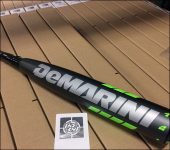
DeMarini Sports uses RFID technology to combat the black market
[ad_1]
DeMarini Sports, a sporting goods company, is using RFID technology to track baseball and softball bats to ensure the integrity of the high-value commodity supply chain. The UHF RFID solution is provided by the Entrigal system. Using this system, the company can automatically create a record of each bat being shipped to a specific retailer. In this way, when the bat is sold elsewhere (such as eBay), the company can identify the original retailer of the bat.
DeMarini sells two types of baseball equipment and clothing, fast throwing and slow throwing, and its aluminum alloy bats usually cost as much as US$200 to US$500. The company produces these bats at its Hillsboro, Oregon plant, and ships 3,000 bats to retailers around the world every day. These retailers will then sell at the prices set by DeMarini. However, sometimes eBay or other websites will sell at lower prices.

(Before transporting the bat to the retail store, DeMrini needs to stick the coded RFID tag on the box)
Nate Baldwin, DeMarini’s factory manager, said: “We have been a high-end bat manufacturer for 20 years. But in the last five years, with the rise of e-commerce, we have encountered some black market problems.” The bats sold are sold at a price lower than the manufacturer’s suggested price (MAP). He pointed out that this is not only a brand image issue, retail stores also need to compete with these online channels.
Some large DeMarini retailers complained about manufacturers and asked them to block these sales channels, but this is not an easy problem. Although DeMarini can buy back these bats online, the company still cannot confirm where these sellers got the goods.
Therefore, the company contacted Entrigal this year. In June of this year, the two jointly launched a solution to automatically identify each bat and bind the bat ID number to the shipping retailer information.
Mark Gemberling, vice president of marketing at Entrigal, said: “Although RFID is a fast and automated method of collecting bat data, there are still some difficulties in the deployment process.”
DeMarini hopes to put RFID tags into the bats to track each bat. However, most low-cost RFID tags are placed in aluminum or alloy bats, and it becomes difficult to read the tags due to the interference of the material on the RF transmission. In addition, since the labels are stacked and shipped, the orientation of the labels is also a problem.
In addition, the bat needs to be specially designed to provide optimal performance, and the insertion of the RFID tag may also interfere with the weight balance of the bat. Baldwin said that not only that, but the label in the bat when a player hits the ball can even affect it. He said: “We almost gave up.”
In the end, DeMarini chose the alternative recommended by Entigral. The program uses an ID number in the form of a QR code.
First, on the assembly line of the Hillsboro factory, workers need to stick a two-dimensional barcode label to the bat. Then, these bats will be sent to the etching machine to scan the tag ID number and automatically etch the same serial number. Then, the bat will proceed to the assembly of the handle and end cap components.
Baldwin said that serial number etching itself is not new. In order to meet the requirements of the baseball league, the company has already etched the serial number on the bat. The difference is that in the past, these bats were not marked with QR code labels.
After the etching process is over, the bat begins to prepare for delivery. Before placing the bat in the box, the employee needs to scan the QR code. Then use the Zebra ZT410 series RFID printer to print and encode the built-in EPC UHF Invengo Shamrock RFID label. The label of the label. The bat SKU number and production date are also printed on the label. At the same time, the Impinj Monza 4 chip in the RFID tag encodes the unique ID number. The ID number of the tag and its binding information are stored in Entigral’s TraxWare software and transferred to the company’s SAP software. The employee will then place the bat in the box and attach an RFID tag to the bottom of the box.
For large orders, RFID-labeled boxes are stacked on pallets, and each pallet is usually loaded with 300 boxes. The boxes are placed with the label facing outwards. Next, the pallet is transported to the stretch film packaging area where the Zebra FX9500 fixed reader is installed. The SAP software pulls out the shipping order information. When the pallet is transferred to the stretch film station, the reader will read the ID number of each bat. The Entigral software transfers this information into the SAP system, which creates a record of shipping the customer. The stretch film process usually takes a few minutes, while the label reading only takes 30 seconds.
For small orders, DeMarini employees directly use the Zebra MC3190-Z handheld reader to read the tag ID and bind customer information.
Baldwin said that the system was officially put into use last summer, and in the months since then, the company has figured out the source of the black market bats. In the end, the company severed relations with a retailer suspected of being a black market channel. He said: “Our goal is to eliminate the black market that drives down MAP prices as much as possible. This will benefit loyal retailers and maintain the high-end image of our brand.”
(Exclusive manuscript of rfid world network, please indicate the source author for reprinting!)
[ad_2]






